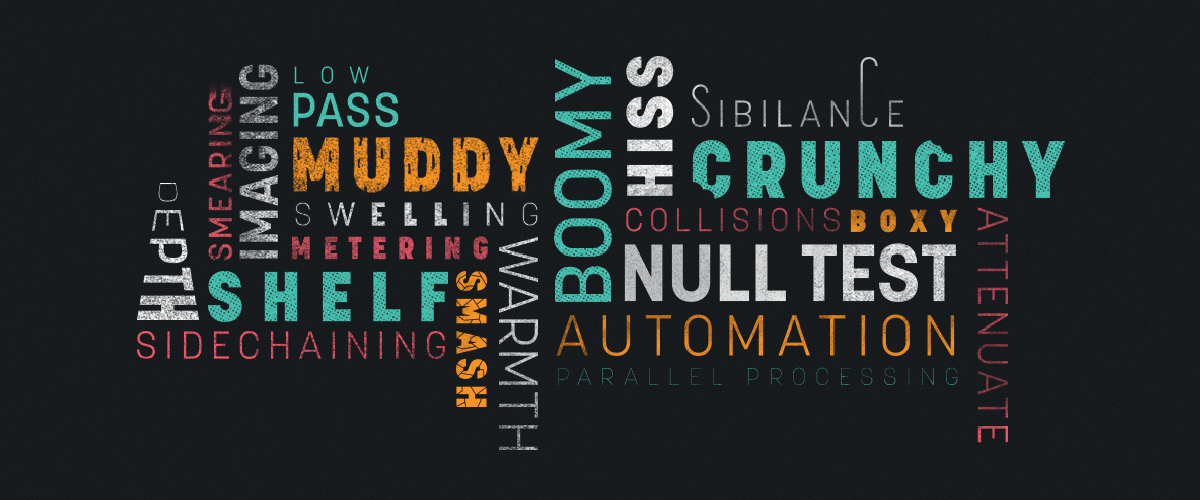
A glossary of common and confusing mixing terms
Confused by audio terms? This easy-to-understand glossary demystifies common audio terminology. Learn the language of sound and improve your understanding of music production, recording, and more.
Audio terminology can be downright confusing. Even familiar words often take on new meanings when used to describe sound. If you’ve ever been on an audio forum, discussed a mix with a client, or read gear reviews, you’ve likely been pelted by a multitude of technical and descriptive terms. To improve your ability to use your software and hardware and communicate effectively with clients, engineers, and producers, you’ll want to learn the language!
What follows is a good start: a digestible glossary designed to clear up some ambiguity.
This list will continue to grow, so check back for more common and confusing mixing terms!
Explore some of these mixing terms using some free mixing plugins from iZotope, including


Vinyl


Vocal Doubler


Ozone Imager V2
Confusing mixing terms
Air: High-frequency content above 12 kHz that contributes to a sense of openness and space. Often enhanced with EQ or exciter plugins to add polish and finesse to a mix or vocal.
Body: The midrange fullness or weight of a sound, typically felt between 200–600 Hz. If a sound is “missing body,” it may feel thin or weak in the mix.
Boomy: A build-up of low to low-mid frequencies – often in drums, bass and guitar – that causes an overpowering emphasis on the sustain of the sound.
Boxy: A lack of low and high frequencies; a sound that has too much midrange.
Chug: A satisfying, detailed, and transient-rich midrange sound; derived from the way guitars often “chug” in heavy metal and rock music.
Cloudiness: A newer term for excessive low-mid buildup (around 200–500 Hz) that can obscure clarity in a mix. Clearing cloudiness often brings more separation and openness to a track.
Creaminess: A subjective description for a smooth, soft, and pleasing balance between the midrange and high frequencies; often associated with vintage EQs and tube compressors.
Crunchy: Slightly distorted as a result of over-compression, over-limiting, clipping, or intentional overdrive.
Fatiguing: A phenomenon in which an aspect of the music – either the frequency balance or the amount of compression – makes a sound annoying to the ear when heard for sustained periods of time (see Metallica, Death Magnetic).
Fizz: An exaggerated emphasis in the upper high-mid, lower-high end range, prominent in vocals, cymbals, guitars, and synths; essential for energy, but too much can contribute to a harsh and fatiguing sound.
Glue: A perceived cohesiveness among elements in a mix, often achieved by applying gentle bus compression.
Growl: a low, throaty, and often distorted character commonly associated with bass, guitars, synths, and vocals.
Hiss: High-frequency noise, typically without any recognizable pitch.
Honky / Nasal / Pinched: A term used to describe a sound that has an emphasis in the midrange frequencies, typically between 400 Hz and 1 kHz; often used when referring to the tone of vocals, guitars, brass instruments, or the whole mix.
Lift: An airy boost in the upper treble range (often 10–16 kHz) that adds brilliance and sparkle. Used frequently on vocals, mixes, and masters to impart clarity and “shine” without adding sibilance.
Muddy: A build-up of low-mid frequencies that reduces the ability to clearly hear individual elements of a mix.
Presence: A sonic quality that emphasizes the upper-midrange (around 2–6 kHz), helping vocals and lead instruments cut through a mix.
Punchiness: The sense of impactful attack, especially in drums or bass; punchiness can come from careful transient shaping, EQ, or compression, and is often desired to make rhythmic elements feel tight and energetic.
Pumping: Short-duration volume surges caused by compression, limiting, or “incorrect” configuration of a compressor/limiter’s settings; can be intentional or accidental.
Ratty: Ratty is used to describe a harsh, distorted, or gritty sound that often appears in a track when the processing goes too far; often the result of overdrive, distortion, or clipping, creating a fuzzy, crunchy character.
Richness: A term describing a full, harmonically complex sound.
Ring: A resonant frequency in an audio track that persists after a sound has been produced, often in the form of a sustained tone; typically heard in snare drums, but can be found in any instrument
Silkiness: A smooth, elegant treble quality with no harshness.
Snarl: A rough, aggressive, and often distorted sound; higher in frequency than “growl” but similar in effect.
Subbiness/Subby: Excessive level in the “subwoofer territory” (sub-low frequencies, typically below 60 Hz).
Warmth: A tonal quality characterized by a pleasurable amount of low-mid and midrange information, usually achieved with mild levels of even-harmonic distortion.
Common mixing terms
Artifact: An unintended side effect or distortion introduced by digital processing – like aliasing, warbling from aggressive noise reduction, or the robotic tone from excessive pitch correction; some artifacts are desirable in creative use, others are considered flaws.
Atmos: Short for Dolby Atmos, an immersive, “object-based” audio format that allows sound to move in three-dimensional space; widely used in film, TV, and now music streaming, Atmos requires specialized routing and rendering during mixing.
Attenuate: Turn down or lower the level.
Automation: Changes to any parameter – such as “volume” or “pan” – that your DAW can both record and play in sync with your project.
Band-pass: A filter that only lets a specific band pass through; often used to filter out highs and lows at the same time.
Brickwall Limiter: A digital limiter that prevents its output from exceeding a defined level regardless of input level
Caterpillar (see log): An over-limited piece of musical material, categorized by the resulting waveform looking like a caterpillar.
Comb filtering: Frequency cancellations occurring in intervals (e.g. 500 Hz, 1.5 kHz, 2.5 kHz, etc), typically due to a delay between multi-miked signals that are being mixed together, or bad room acoustics/room treatment decisions.
De-click: A restoration process that targets short, transient noises – like pops, clicks, or digital glitches; commonly used to clean up vocal recordings, vinyl transfers, or podcast audio.
De-essing: The process of reducing sibilance – harsh “S” and “T” sounds – using a dynamic processor that targets high-mid frequencies.
De-noise: A process or plugin designed to reduce or remove unwanted background noise – like hum, hiss, or AC buzz – without damaging the core signal.
Depth: Differentiation between close and distant sounds.
Dim: A quick attenuation of output level, often engaged via a monitor controller; used for checking balances at lower levels or for reducing volume without changing fader positions.
Filter: A processing tool used to reduce or remove certain frequency ranges; filters include high-pass, low-pass, band-pass, and notch varieties, each with unique applications in shaping tone or cleaning up audio.
Flip the phase (see “Reverse Polarity”): To invert the positive and negative excursions of a signal 180 degrees. Positive excursions become negative and negative excursions become positive.
Hard clip: A style of distortion that abruptly limits or “flattens” a signal at a set threshold, introducing sharp harmonic content.
Harmonic distortion: Coloration or modification of a signal caused by the introduction of a series of harmonics.
Harmonics: multiples of a fundamental frequency (e.g. 2 kHz is the 2nd harmonic of 1 kHz)
Harshness: An excessive amount of high frequencies.
High-cut filter: Another term for a low-pass filter; much preferred by younger engineers.
High-pass filter: A type of filter that removes low-frequency content below a set frequency while allowing higher frequencies to pass; commonly used to clean up low-end rumble or tighten up non-bass instruments.
Imaging: The ability to accurately position or distinguish signals in the left-to-right stereo field.
Immersive: A general term for audio experiences that go beyond traditional stereo or surround; includes formats like Dolby Atmos, Sony 360 Reality Audio, and Ambisonics.
Items / Regions: Terms used in DAWs (like Reaper, Pro Tools, or Logic) to describe “clips” or “chunks” of audio that exist within tracks; items and regions can be edited, moved, or processed independently.
Jitter: a form of digital distortion caused by timing errors in the clocking of digital audio signals; can result in subtle but unpleasant artifacts or loss of stereo imaging, especially during AD/DA conversion.
Kill: A DJ or live-engineer term for muting a frequency band or an entire signal; has nothing to do with actual violence.
Key: To route a signal into a processor’s sidechain input. See “sidechaining.”
Log (see caterpillar): An over-limited piece of musical material, categorized by the resulting waveform looking like a log.
Low-pass filter: A filter that reduces high frequencies at a set decibel per octave value, but allows low frequencies to pass through unaffected.
Low-cut: Another term for a high-pass filter; preferred by younger engineers.
LUFS: Loudness Units Full Scale – a standardized measurement of perceived loudness over time. LUFS is now the dominant measurement for streaming normalization and broadcast compliance.
Metadata: Embedded data that describes or tags audio files – such as artist name, tempo, key, ISRC, or descriptive notes. Important for distribution, licensing, and archival purposes.
Metering: A tool used to help measure and evaluate the level of a signal in a variety of different ways.
Mouth Noise: Unwanted lip smacks, saliva clicks, and other artifacts produced during close-mic’d vocal recording. Often edited manually or treated with specialized de-click tools.
Multitracks: The raw, individual audio files from a session – each microphone or instrument recorded on its own track. Multitracks are used for full mixes and re-mixes from scratch.
Normalization: Adjusting an audio file’s gain so that its peak or average level meets a specific target. Can be done to match LUFS, peak levels, or RMS, depending on the application.
Null test: The process of combining two presumably identical signals at identical volume and pan positions, with the polarity of one signal flipped. They will null (completely cancel out) and yield no output signal if they are identical.
Parallel processing: Applying processing to a copy of an original signal and mixing the copy and the original together.
Phase-align: A more surgical approach than time-aligning, phase-aligning involves adjusting the phase relationship of two signals to reduce cancellation and improve cohesion. Tools like all-pass filters or dedicated plugins are often used.
Phasing: Timing differences when combining identical (or nearly identical) signals. This can be a result of static delay between the signals, and can also come from extreme boosts when using non-linear phase EQs.
Plosives: Sudden bursts of low-frequency energy from “P” or “B” sounds in vocal recordings.
Ref: shorthand for reference track. “Let me pull up a ref” is a common phrase during mix sessions.
Reference: A professionally mixed or mastered track used as a benchmark to compare tonal balance, dynamics, width, and loudness during mixing or mastering.
Resonance: A phenomenon where certain frequencies are exaggerated due to the interaction between sound waves and the physical/acoustic properties of an environment. In the context of mixing, resonance can occur in both the instruments and the room itself, leading to unwanted buildup in certain ranges, particularly in the low mids. It is often controlled or reduced using EQ, through careful mic placement, and with room treatment.
Resonant peaks: occasional volume boosts at specific frequencies, resulting from the sum of multiple signals creating an increase in energy that is most noticeable in a limited frequency range. Among other things, resonant peaks can be caused by filter ring, mic placement, room modes, and multiple instruments hitting the same frequency area.
Rough or Ruff: A rough mix – an early, unfinished version of a song. The rough is often used to communicate vision or feel before detailed mixing and processing take place.
Sample augment: layering a sample on top of a live or existing drum hit to enhance tone or add consistency without fully replacing the original sound.
Sample replace: replacing a recorded drum hit (typically a snare or kick) with a pre-recorded sample. Used to fix poorly recorded drums or maintain consistency in a performance.
Saturation curve: The unique way a saturation processor adds harmonics as input level increases. Different saturation curves produce different tonal characteristics – some soft and musical, others aggressive and buzzy.
Shelf: An EQ that applies a consistent boost or cut to all frequencies above or below a defined frequency.
Sibilance: Spikes in loudness at high-frequencies in vocal tracks, often caused by sharp consonant sounds such S’s and T’s.
Sidechaining: Using one signal to trigger a processor on a different signal (typically feeding the sidechain of a compressor with an altered or secondary signal).
Sidechain input: A dedicated input that “tells” a processor how to behave; typically found on compressors, sidechain inputs can be filtered or EQ’d differently to the input signal, focusing the compression in more specific ways.
Smash: Aggressively compress/limit a signal.
Smearing: Decreased ability to distinguish the positioning of signals in the left-to-right stereo field or front-to-back imaging space. Can be a byproduct of overprocessing.
Soft clip: A form of distortion that rounds off transients at the threshold, rather than chopping them off sharply like a hard clip. Soft clipping can add warmth and density to drums, vocals, or mix buses without sounding overly aggressive.
Stems: Grouped audio files exported from a DAW that consolidate similar elements (e.g., all drums, all vocals, all guitars). Stems are often used in mastering, remixing, or live performance.
Tilt EQ: An EQ that simultaneously boosts highs while cutting lows – or vice versa – pivoting around a central frequency. Popular for quickly rebalancing tonal characteristics, especially in mastering workflows.
Time-align: the process of nudging one audio element in time so its transient lines up with another; commonly used on multi-mic drum setups or layered sounds to preserve punch and avoid phase issues.
Tonal balance: The distribution of energy across the audio spectrum.
Trackouts: a hip-hop and pop term for all individual elements of a beat or instrumental – similar to multitracks, but often refers to production sessions where instruments and loops are provided for further mixing.
Tracks: can refer to either the audio lanes in a DAW session (e.g., a snare track) or the individual songs on a record, depending on context.
Transients: The initial attack portion of a sound, typically occurring within the first few milliseconds. Preserving or shaping transients is essential for achieving punch and clarity, particularly in drums and plucked instruments.
Unity gain: A setting where the input equals the output.
Volume: In scientific terms, this refers to the space a liquid occupies–not sound. In audio, more accurate to talk about ‘level’ or ‘loudness’.
Width: The perceived difference in left-to-right spacing between signals (how “far apart” signals sound).
Refer to this list of mixing terms often
Hopefully, this glossary cleans up the murky waters of mixing terminology. By adding these terms to your toolkit, you'll not only enjoy smoother communication with collaborators but also gain a clearer understanding of the craft itself, empowering you to make more informed decisions in your own mixes.


